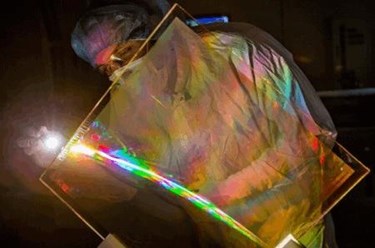Anti-Reflective Optical Coating Boosts World's Most Powerful Laser
By Jof Enriquez,
Follow me on Twitter @jofenriq

Scientists at the Lawrence Livermore National Laboratory (LLNL) in California have developed a new anti-reflective coating to protect laser optics, and a new chemical process that makes the optics more resistant to damage. The two technologies will help reduce operational costs and boost the energy output of the National Ignition Facility (NIF), the world's largest and highest-energy laser system.
During the firing of NIF's laser beams, an optical component called the grating debris shield (GDS) helps diagnose the energy emitted by the laser by diffracting a small amount of laser light and sending it to a device used to measure the actual energy. This helps balance the laser's energy as it enters the target chamber.
"These gratings have to be very stable," Marcus Monticelli, LLNL process engineer lead, said in a press release. "The way to keep it stable, historically, was to leave it uncoated, because the index of refraction of the coating can change with time. That will affect diffraction efficiency significantly, and that would cause power balancing issues on NIF."
At the ultraviolet wavelength, a fused silica optic like the GDS reflects 3.7 percent of the laser energy up the beamline, and must be captured by a beam dump to minimize collateral damage to other optics. However, with each laser fired, some of the reflected light creates a focusing "ghost" intense enough to damage the integrated optics module's (IOM) stray-light-absorbing glass, just above the exit surface of the GDS. It also scatters debris particles across the GDS, which creates damage sites that grow larger as it gets exposed to repeated laser beams over time, which ultimately renders it unusable. As a result, NIF engineers have to remove and repair 30-40 optics a week to make the NIF's lasers operate at maximum efficiency.
With support from LLNL's Laboratory Directed Research and Development (LDRD) program, researchers utilized a sol-gel chemical process to create a colloidal silica particle coating that was applied on the grating surface of the GDS to reduce the reflections from the rear surface of the GDS. A patented chemical process, called the Advanced Mitigation Process (AMP), further protects the optics, making their surfaces more damage-resistant by removing impurities and absorbing microfractures, according to LLNL.
Only about one quarter of uncoated GDS in NIF's lasers are left and will be replaced soon. Once all new GDS models with the new coatings are installed, LLNL scientists expect to cut in half the recycling rate for damaged optics, to only about 10-20 a week. It will also significantly lessen the cost of buying new GDS units, from 130 to about 40 units annually.
NIF experiments support the National Nuclear Security Administration's Stockpile Stewardship Program. It also builds state-of-the-art, ultra-high-power laser systems to conduct groundbreaking scientific research.
However, its major objective is to achieve the ignition of nuclear fission. Although the $3.5 billion facility has made "technical progress" since its opening in 2009 toward this ambitious goal, a 2016 report from the Department of Energy (DOE) says "achieving ignition on the NIF in the near term (one to two years) is unlikely and uncertain in the mid-term (five years)," according to Science Magazine.
